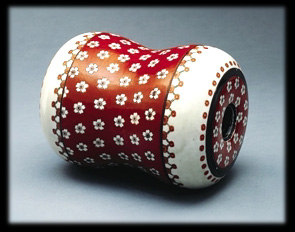

![]()

Drum-Shaped Pillow
Saga Prefecture
Edo period, late 18th-early 19th century
Porcelain painted with overglaze enamels and gold (Arita ware, Imari style)Although porcelain pillows were used in East Asia by both sexes, this type seems to have been made specifically for women. As an object connected to personal adornment, it was intended to preserve a woman's elaborate coiffure as well as her status as an object of desire to men.
Representing Japanese Women
The objects in this section represent women, or were made for them, in the Edo period (1600-1868). Porcelain pillows offer insight into aspects of domestic female patronage, while female figurines represent a popular type of decorative sculpture created out of molds and exported to European markets. Pillows were commonly used to protect the elaborate and modish hairstyles of well-to-do women. Dainty Japanese female figurines depicted in the ornate costume and delicate coiffure of courtesans of the Kanbun era (1661-1673) became fashionable for European collectors. Together with representations of the "beautiful woman" (bijin) theme such as on woodblock prints, these images strongly reflect and influence the way in which Japanese women are portrayed, imagined, and marketed in the West even today.